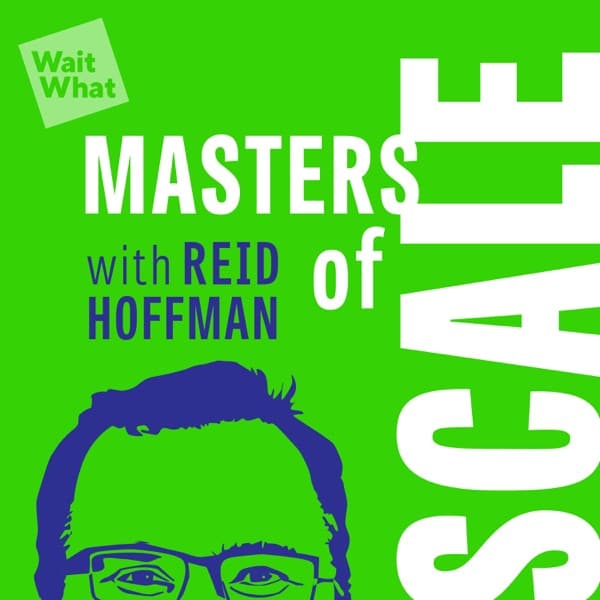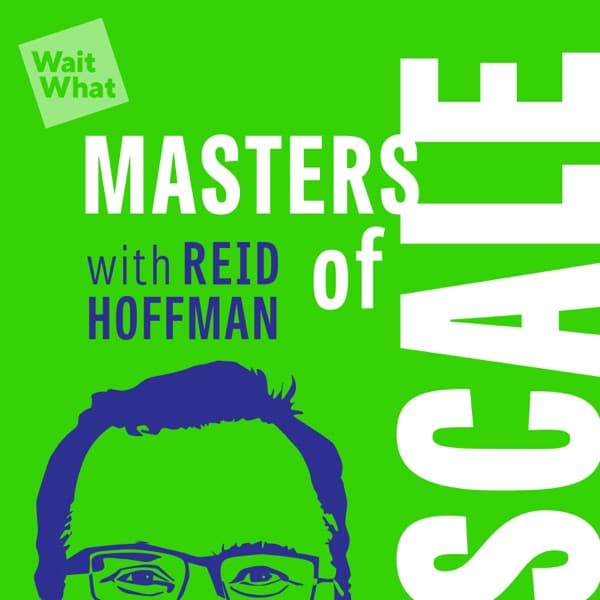Modern Wisdom: The discussion explores the impact of remote work, the value of in-person interactions, and the evolving workplace dynamics post-lockdown.
How I Built This with Guy Raz: Monica Nassif created successful cleaning brands, Caldrea and Mrs. Meyer's, by innovating in the upscale and accessible cleaning product market.
The Twenty Minute VC (20VC): Venture Capital | Startup Funding | The Pitch: The discussion centers on Grok's innovative approach to AI inference, emphasizing its cost-effectiveness and scalability compared to NVIDIA's GPUs, and the potential of synthetic data in AI training.
TechCrunch Startup News: Aptronic, a robotics startup, raised $350 million to advance humanoid robots, focusing on industrial applications and future age tech.
TechCrunch Startup News: Uber Eats is expanding its use of autonomous delivery robots in Jersey City, partnering with AVRide to enhance delivery efficiency.
Modern Wisdom - #904 - Rory Sutherland - The Secret Weapons Of Marketing Psychology

The conversation delves into the effectiveness of companies in bringing employees back to the office post-lockdown, highlighting the differences between tech and ad industries. It emphasizes the importance of balancing remote work with in-person interactions for productivity and serendipitous collaboration. The discussion also touches on geographical differences in remote work adoption, with the US showing higher absenteeism compared to the UK. The conversation further explores the impact of remote work on team dynamics, using examples like team meetups leading to unexpected outcomes such as pay rise requests. Additionally, the discussion highlights the lack of investment in remote working technology and the architectural challenges in adapting office spaces for video calls. The conversation concludes with insights into consumer behavior, emphasizing the need for slow decision-making processes and the pitfalls of fast, deterministic approaches in business.
Key Points:
- Remote work increases productivity by allowing discretion over work environment.
- In-person interactions are crucial for collaboration and serendipity.
- US shows higher remote work adoption than UK, affecting office occupancy.
- Investment in remote work technology is lacking, impacting productivity.
- Consumer behavior benefits from slow, exploratory decision-making processes.
Details:
1. 🏢 Navigating the Return to Office and Remote Work Balance
- Tech companies in the UK remain largely empty, indicating a slow return to office in tech-driven industries, which may be due to their heavy reliance on digital communication and remote work capabilities.
- In contrast, the ad industry has achieved a balanced return to office, reflecting a more social work culture that benefits from in-person collaboration and creativity.
- A flexible work environment, allowing 20-40% of time for remote work, is preferred for productivity in knowledge economy roles, as it balances focus with the need for collaboration.
- Collaboration and serendipity require physical presence, highlighting the need for some degree of co-location to foster innovation and spontaneous interactions.
- Absenteeism is higher in the US and Canada compared to the UK, potentially due to geographical reasons and remote relocations, which might affect in-person attendance and engagement.
2. 🌍 Cultural and Geographic Variations in Work Habits
2.1. US and Canada Work Trends
2.2. European and UK Work Trends
3. 👥 The Intricacies of Team Building in a Virtual World
- A Machiavellian approach suggests compartmentalizing staff to prevent collective bargaining, such as negotiating pay raises, which can impact team cohesion.
- A 1990s agency found that assertiveness training led to employee resignations, indicating risks in upskilling without considering employee retention strategies.
- Despite expectations for advanced home technology, there is frustration over the lack of significant investment in remote working hardware, which can hinder productivity.
- Google Starline, a developing project, aims to revolutionize remote communication through 3D video conferencing, enhancing virtual interaction.
- Office spaces have decreased in size but are inadequately equipped for video calls, lacking sufficient private pods while having too many meeting rooms, which affects remote collaboration effectiveness.
4. 🔧 Embracing Technology: Remote Work and Consumer Behavior
- Consumer behavior shifts significantly once new technology is embraced, making previous habits appear outdated.
- The music industry initially resisted digital downloads, similar to how traditional work environments resisted remote work.
- Once consumers experienced digital music downloads, the necessity of buying CDs was questioned, illustrating a shift in consumer expectations.
- The analogy extends to remote work, where the conventional necessity of commuting to an office is reevaluated once remote work is experienced.
5. 📈 Evolving Work Dynamics: Productivity and Flexibility
- The shift to remote work, where individuals can join meetings directly from bed, highlights a significant change in daily routines, making traditional morning preparations seem cumbersome, thereby increasing flexibility.
- Technological advancements, such as instant boiling water taps, illustrate how once people experience new conveniences, they find previous methods outdated, leading to efficiency gains in daily tasks.
- Electric cars serve as an example where initial resistance is overcome once the change is made, leading to lasting adoption and no return to traditional options, demonstrating a shift in productivity and environmental consciousness.
- These changes collectively indicate a trend towards increased adaptability and a preference for convenience, which can enhance productivity by reducing time spent on traditional routines and increasing focus on core tasks.
6. 📊 Strategic Business Adaptations and Feedback Mechanisms
- First movers in an industry often face significant marketing costs to introduce both a new brand and product ecosystem, which can diminish their advantage.
- Early technologies typically attract status-seeking consumers rather than those focused on utility, exemplified by the adoption patterns of early automobiles and the Apple Vision Pro.
- The Apple Vision Pro highlights a strategy where appealing to novelty and status can create a market presence even when immediate utility is limited.
7. 🚗 Jaguar's Innovative Brand Transformation
- The initial evolution of plumage and wings in birds and dinosaurs was primarily for sexual display, eventually evolving for transportation as wings became capable of supporting flight.
- This evolutionary analogy is applied to technological advancements, such as the typewriter's transition from a tool for clearer writing to a staple in business communication, exemplifying how initial advantages in a feature can lead to broader, transformative applications.
- The analogy serves as a metaphor for Jaguar's brand transformation, suggesting that initial changes for aesthetic or functional improvements can evolve into significant strategic advantages.
8. 🏠 Housing, Wealth Inequality, and Generational Impact
8.1. The Evolution of Business Communication and Its Implications
8.2. Impact on Housing and Wealth Inequality
9. 🌆 Urban Living, Lifestyle Choices, and Cultural Preferences
- Netflix CEO revealed a significant spike in viewing between 12 and 1 PM in many countries, indicating a cultural shift towards digital entertainment during lunchtime.
- This trend highlights a lifestyle change where individuals prefer online streaming over traditional lunchtime activities, such as dining out or socializing offline.
- Businesses can leverage these insights by targeting digital marketing efforts during lunchtime hours to capture the attention of viewers.
- Understanding these viewing patterns can aid in strategizing content release times to maximize audience engagement and retention.
- Incorporating these insights, companies can better align their digital strategies with evolving consumer preferences for on-demand entertainment.
10. 🚦 The Economics of Road Pricing and Fairness
- Implementation of road pricing can lead to a 20% reduction in traffic congestion, significantly improving urban mobility.
- Dynamic pricing models adjust tolls based on real-time traffic conditions, optimizing road usage and reducing peak demand.
- Fairness concerns arise from road pricing, as lower-income individuals may be disproportionately affected compared to wealthier drivers.
- Subsidies or tiered pricing structures can mitigate fairness issues by providing discounts to economically disadvantaged groups.
- Successful examples include Singapore and Stockholm, where road pricing has reduced congestion by 30% and increased public transport usage by 20%.
- Revenue generated from road tolls can be reinvested into public transportation infrastructure, further enhancing mobility options for all citizens.
- Public acceptance of road pricing increases when revenues are transparently allocated and communicated to improve transport services.
11. 💸 Taxation Policies and Economic Strategy Debates
- Empowering employees to tailor their work environment leads to enhanced productivity, as it caters to individual preferences and needs.
- Recognizing diverse work styles, such as some employees needing silence while others thrive with ambient noise, highlights the importance of customizable workspaces.
- Providing autonomy in workspace management can significantly boost productivity, even if this flexibility is only offered part-time.
How I Built This with Guy Raz - Mrs. Meyer's Clean Day: Monica Nassif

Monica Nassif, after leaving her marketing agency, identified a gap in the household cleaning product market for upscale and aesthetically pleasing products. She launched Caldrea, a luxury cleaning brand, which was sold in gift shops and upscale stores. Recognizing the limitations of Caldrea's market reach, she created a more accessible brand, Mrs. Meyer's, named after her mother, which combined luxury with affordability. Mrs. Meyer's quickly gained traction in major retailers like Target and Whole Foods. Nassif's strategy included leveraging her mother's image as a brand mascot and focusing on unique fragrances and attractive packaging. Despite initial challenges, including a failed attempt at entering Target prematurely, the brand eventually succeeded, leading to its acquisition by SC Johnson. This acquisition allowed for global distribution and significant growth, demonstrating the power of strategic brand positioning and market adaptation.
Key Points:
- Monica Nassif launched Caldrea as a luxury cleaning brand, focusing on upscale aesthetics and unique fragrances.
- Mrs. Meyer's was created as a more accessible brand, combining luxury with affordability, and was named after Nassif's mother.
- Strategic use of PR and brand mascots helped Mrs. Meyer's gain traction in major retailers like Target and Whole Foods.
- Initial challenges included premature entry into Target, which was later corrected by building brand awareness first.
- The eventual acquisition by SC Johnson allowed for global distribution and significant brand growth.
Details:
1. 🎧 Wondery Plus & Sponsorships
- Wondery Plus subscribers have early access to 'How I Built This', allowing them to engage with content before the general public.
- The subscription offers an ad-free listening experience, enhancing user enjoyment and satisfaction.
- Subscriptions can be obtained via the Wondery app or Apple Podcasts, providing flexibility in platform choice.
- Additional benefits include exclusive content and convenient access to a vast library of shows.
2. 💳 American Express & Vital Proteins Sponsorships
- The American Express Business Platinum Card offers flexible spending limits that adapt to your business needs, giving you the ability to scale your expenditures as required.
- Earn 1.5 times membership rewards points on select business purchases including airfare and advertising in select media, which significantly enhances your rewards potential and savings.
- Enjoy complimentary access to over 1,400 airport lounges worldwide, including the Centurion Lounge, providing a strategic advantage for frequent travelers by keeping you connected and comfortable on the go.
- The card provides world-class business and travel benefits such as travel insurance and purchase protection, supporting business owners in pursuing their passions and growth while ensuring peace of mind.
- Comparison to other cards: Unlike many competitors, this card offers a unique combination of spend flexibility and premium travel benefits, making it ideal for businesses with significant travel and advertising expenses.
3. 🏠 Airbnb & Mrs. Meyers Story
3.1. Introduction and Sponsor Messages
3.2. Benefits of Collagen and Personal Testimonial
3.3. Airbnb Hosting Opportunity
4. 👩👧 Monica Nassif's Entrepreneurial Journey
- Monica Nassif used her mother's persona 'Mrs. Myers' as a relatable brand ambassador, significantly enhancing consumer connection at key retail locations like Whole Foods.
- By incorporating a real-life figure such as Mrs. Myers in marketing strategies, brands can be humanized, leading to more effective customer engagement and loyalty.
- Monica's strategy allowed her mother to take public credit, leveraging authenticity and personal storytelling, which contributed to business growth and brand differentiation in a competitive market.
- The approach of using Mrs. Myers as a brand ambassador resulted in increased brand recognition and consumer trust, driving sales and reinforcing the brand's presence in the eco-friendly cleaning products sector.
5. 🧼 Launching the Caldrea & Mrs. Meyers Brands
- Monica Nassif successfully launched two household cleaning brands, Caldrea and Mrs. Meyers, focusing on aesthetics and branding to differentiate from competitors.
- Mrs. Meyers, named after Nassif's mother, became a recognizable brand mascot, contributing significantly to brand growth and customer loyalty.
- Caldrea positioned itself as an upscale, luxury brand, initially selling in gift shops and high-end stores like Williams-Sonoma, while Mrs. Meyers targeted a broader market with a balance between luxury and affordability.
- Monica's strategy to create a more accessible product line allowed Mrs. Meyers to enter mainstream retailers like Target and Whole Foods, driving significant growth by the mid-2000s.
- Both brands were eventually acquired by SC Johnson, indicating their success and brand value.
- An important business strategy Monica employed was self-disruption by creating a cheaper version of her own product to capture a different market segment.
- The brand's growth faced challenges initially, particularly in raising capital, but Monica's persistence and adaptability were key to overcoming these obstacles.
6. 👩👦 Family, Childhood, and Personal Life
6.1. Family Dynamics
6.2. Personal Responsibilities and Childhood
7. 💼 Shift from Nursing to Marketing
- The speaker emphasizes the importance of securing a job over academic grades, highlighting a family philosophy prioritizing financial independence through employment over educational achievements.
- The speaker had multiple majors at the University of Iowa, including journalism, photography, Spanish, and eventually nursing, which she completed in five years.
- The decision to choose nursing was driven by job availability, leading to academic improvement and a focus on achieving straight A's.
- Graduated in 1979 with a nursing degree, demonstrating adaptability and potential for career change.
- Married college sweetheart, David Nassif, at a young age, balancing personal relationships with professional development.
- The transition from nursing to marketing involved leveraging skills and experiences gained in nursing to explore new career opportunities, emphasizing the importance of adaptability and continuous learning.
8. 💡 Business Ideas and Failures
8.1. Relocation and Nursing Career Start
8.2. Challenges in Nursing
8.3. Shift to Corporate Communications
8.4. Balancing Family and Career
9. 🔄 Learning from the Watch Company Failure
9.1. 🚫 Failure of the Watch Company Initiative
9.2. 📘 Lessons Learned from the Failure
10. 🛍️ Carving a Niche in the Cleaning Market
- The individual was dissatisfied with consulting, where their product suggestions were often ignored, leading to a desire to create their own product line.
- A significant moment came upon seeing poorly presented cleaning products in a store, which sparked the idea for a high-end, aesthetically pleasing cleaning product line similar to Aveda's success in the beauty industry.
- The concept involved creating a range of cleaning products available in a singular fragrance, providing a cohesive sensory experience, and elevating the consumer's perception of cleaning.
- Market research explored historical cleaning methods using natural ingredients, indicating a niche for aesthetically pleasing, naturally inspired cleaning solutions.
- The vision was to transform cleaning from a mundane task to an enjoyable experience, incorporating appealing fragrances and storytelling about product ingredients and origins.
11. 🧴 Developing Caldrea Products
11.1. Identifying Market Opportunity
11.2. Personal Background and Motivation
11.3. Launching the Product Line
11.4. Networking for Production
11.5. Product Development and Testing
11.6. Building a Team
12. 🏪 Strategic Retail Partnerships
12.1. Fundraising Strategies
12.2. Strategic Partnerships and Insights
13. 🔍 Brand Strategy and Market Positioning
13.1. Initial Brand Strategy and Product Launch
13.2. Market Positioning and Partnerships
14. 👩🌾 The Inspiration Behind Mrs. Meyers
- Mrs. Meyers was conceptualized as a direct competitor to the European brand Caldrea. The idea was to create a product that was Midwestern, wholesome, and garden-inspired, drawing from the founder's personal background and family values.
- The brand was named after the founder's mother, Thelma Meyer, who embodied a thrifty, practical lifestyle with a strong emphasis on waste not, want not, stemming from her experience during the Great Depression.
- The initial branding and packaging of Mrs. Meyers products included a retro design reminiscent of a 1950s housewife, which was meant to evoke authenticity and authority from a domestic mentor. The packaging was designed to look homemade, yet sophisticated, incorporating 50s iconography.
- The product development process was rapid, taking less than a year to move from concept to market, including seven months of stability testing. This swift development was crucial for entering a competitive market.
- Restoration Hardware became the first customer for Mrs. Meyers, recognizing the brand's potential at a trade show. The brand targeted Whole Foods as a strategic entry point to leverage influential buyers and achieve broader market presence.
- A key marketing strategy was to push for brand blocking in stores, ensuring all Mrs. Meyers products were displayed together rather than scattered, to strengthen brand recognition and the halo effect among consumers.
15. 📺 QVC Experience and Lessons Learned
15.1. Sampling Initiative with Personal Touch
15.2. Media Relations and Key Messaging
15.3. Challenges and Learnings from QVC Experience
16. 🎯 Expanding into Target and Market Challenges
16.1. Initial Pitch to Target
16.2. Results of Target Test
16.3. Challenges with Market Concentration
16.4. Reapproaching Strategy
16.5. Metrics for Re-pitching Target
16.6. Financial Growth and Profitability
17. 💼 Growth and Acquisition by SC Johnson
- The potential market was identified as nearly $10 billion, with the aim to capture a significant portion, leading to revenues between $20 and $30 million, showcasing substantial growth.
- SC Johnson, recognizing the potential for global distribution and leveraging its expertise in fragrance and cleaning, offered an acquisition to capitalize on the company's market position.
- The acquisition, completed for an undisclosed amount, provided financial security and allowed founders to leverage their brand's success globally.
- Key personnel, including the founder and chemist, remained post-acquisition, ensuring continuity and retention of expertise.
- The strategic acquisition aimed to integrate the product line into SC Johnson's global distribution channels, enhancing market reach and operational synergies.
18. 👗 Venturing into Luxury Sleepwear
18.1. Inception and Initial Steps
18.2. Challenges and Decision to Cease Venture
19. 🛒 Mrs. Meyers' Continued Success and Reflections
19.1. Scalability and Market Penetration
19.2. Entrepreneurship and Investment Strategies
19.3. Work Ethic and Timing
19.4. Brand Legacy and Personal Commitment
20. 🎙️ Show Wrap-Up and Production Details
- The show was produced by Kerry Thompson, with music composed by Rantina Ablui, and edited by Neva Grant.
- Research assistance was provided by Carla Estevez.
- Engineering was handled by Patrick Murray and Jimmy Keeley.
- Additional production staff included Alex Chung, JC Howard, Catherine Seifer, Chris Massini, Sam Paulson, John Isabella, and Elaine Coates.
- Listeners can access the show early and ad-free by joining Wondery Plus on the Wondery app or Apple Podcasts.
- Prime members have the option to listen ad-free on Amazon Music.
- A short survey is available at wondery.com/survey to gather listener feedback.
The Twenty Minute VC (20VC): Venture Capital | Startup Funding | The Pitch - 20VC: NVIDIA vs Groq: The Future of Training vs Inference | Meta, Google, and Microsoft's Data Center Investments: Who Wins | Data, Compute, Models: The Core Bottlenecks in AI & Where Value Will Distribute with Jonathan Ross, Founder @ Groq

The conversation highlights Grok's strategic focus on AI inference, positioning itself as a cost-effective alternative to NVIDIA's GPUs. Grok's approach involves using a large number of chips to keep model parameters live, improving energy efficiency by 3x compared to traditional methods. This method allows Grok to offer inference at more than 5x lower cost than NVIDIA, with a focus on scaling without the constraints of high bandwidth memory (HBM). The discussion also touches on the potential of synthetic data in AI training, suggesting that models can generate better quality data for training, thus improving efficiency beyond traditional scaling laws. Grok's business model involves partners funding the deployment of chips, allowing for rapid scaling without capital constraints. The conversation also explores the broader implications of AI advancements, including the potential for AI to transform industries and the importance of maintaining human agency in the age of AI.
Key Points:
- Grok offers AI inference at over 5x lower cost than NVIDIA, focusing on scalability and energy efficiency.
- Synthetic data can enhance AI training by providing higher quality data, improving model efficiency.
- Grok's business model involves partners funding chip deployment, enabling rapid scaling without capital constraints.
- AI advancements could lead to significant industry transformations, emphasizing the need for maintaining human agency.
- Grok aims to provide half of the world's AI inference compute by 2027, focusing on aggressive scaling and market relevance.
Details:
1. 🌊 Riding the AI Wave: Strategic Positioning and Growth
1.1. Strategic Positioning in the AI Industry
1.2. Growth and Market Relevance
2. 🔍 AI Market Dynamics: NVIDIA's Role and the Future of Computing
2.1. NVIDIA's Market Position
2.2. Jonathan Ross and Grok
2.3. Coda's Impact on Team Collaboration
3. 💻 Innovations in Collaboration and Expense Management
- Coda integrates the flexibility of documents, structure of spreadsheets, and power of applications with AI intelligence to streamline enterprise tasks.
- Specifically designed to enhance alignment and agility, Coda assists startup teams in transitioning from planning to execution more efficiently.
- The platform's AI-driven capabilities allow for personalized and adaptive workflows, improving team productivity and collaboration.
- Coda's promotional offer provides startups with six free months of the team plan, eliminating initial financial barriers and allowing teams to experience the platform's benefits firsthand.
4. 📈 Scaling Laws and Strategic Positioning in AI
4.1. Streamlining Finances with PLEO
4.2. Automating Security Compliance with Vanta
4.3. Understanding the Limits of Scaling Laws
4.4. Efficiency and Complexity in AI Models
4.5. Bottlenecks in AI Development
4.6. Strategic Positioning and Scaling Inference
4.7. Innovations in Compute Infrastructure
4.8. Market Dynamics in AI Compute
4.9. Scaling Challenges and Strategic Partnerships
5. 🛠️ Infrastructure and Deployment Challenges in AI
5.1. Power Capacity and Future Bottlenecks
5.2. Data Center Challenges and Mismanagement
5.3. Infrastructure Investment Duration Mismatch
5.4. Flexibility in Resource Utilization
5.5. Strategic Partnerships and Profitability in AI
6. 🚀 Navigating the AI Investment Boom: Opportunities and Risks
6.1. Market Strategy and Growth
6.2. Industry Dynamics and Competition
6.3. Investment Risks and Opportunities
7. 🌍 Global AI Competition: US, China, and European Dynamics
7.1. Investment Dynamics and the Keynesian Beauty Contest
7.2. Talent and Compensation Challenges
7.3. Model and Data Handling Strategy
8. ⚖️ The Balance of AI Innovation, Regulation, and Safety
8.1. NVIDIA's Strategic Direction
8.2. Efficient Scaling and Automation
8.3. Talent Management and Growth Challenges
8.4. International AI Competition and Strategy
8.5. China's AI Strategy and International Perception
9. 🌱 AI's Societal Impact: From Abundance to Human Agency
9.1. AI's Influence on Innovation and Regulation in China
9.2. Geopolitical Competition in AI Development
9.3. Strategies to Enhance Europe’s AI Ecosystem
9.4. Preserving Human Agency in the Age of AI
10. 🔮 AI's Future: Predictions, Innovations, and Industry Shifts
10.1. Good Enough Approach
10.2. Hiring and Innovation
10.3. AI and Industry Competition
10.4. Leadership and Alignment
10.5. Market Dynamics and Strategy
10.6. Future Growth and Investment
10.7. AI Predictions and Innovations
10.8. Product Market Fit
10.9. Defining Companies and AI Challenges
11. 🎙️ Reflections on AI's Path Forward and Closing Thoughts
11.1. AI Hardware & Software Engineering
11.2. AI in Healthcare
11.3. Prompt Engineering & Entrepreneurship
11.4. Business Tools Impact
TechCrunch Startup News - Apptronik, which makes humanoid robots, raises $350M as category heats up

Aptronic, a University of Texas spin-out, secured a $350 million Series A funding round led by B Capital and Capital Factory, with participation from Google. The funding aims to advance the development and commercialization of humanoid robots, particularly for industrial applications. Aptronic's CEO, Jeff Cardenas, highlights the company's decade-long experience in humanoid robotics as a key differentiator from competitors like Tesla and Boston Dynamics. The partnership with Google's DeepMind focuses on developing AI models for bipedal robots, with plans for scaling and production in 2026 and beyond. Aptronic's current projects include pilot deals with companies like Mercedes and GXO Logistics, focusing on tasks such as tote moving in automotive manufacturing. The company also sees potential in age tech, where humanoids could assist the elderly in living independently. However, the high cost of these systems currently limits their use to industrial settings, with a target price for their Apollo robot below $50,000. Aptronic plans to increase its workforce by 50% over the next year to support these initiatives.
Key Points:
- Aptronic raised $350 million to develop humanoid robots, focusing on industrial applications.
- Partnership with Google's DeepMind aims to create advanced AI models for robots.
- Current projects include pilot deals with Mercedes and GXO Logistics.
- Aptronic plans to increase its workforce by 50% to support scaling efforts.
- The company sees future potential in age tech for assisting the elderly.
Details:
1. 🎓 Empower Your Entrepreneurial Journey with OneDay
1.1. Program Details and Benefits
1.2. Application Process
2. 🤖 Aptronic's $350M Leap: Transforming Humanoid Robotics
- Aptronic secured a $350 million Series A round led by B Capital and Capital Factory, with participation from Google. This substantial investment is aimed at advancing their humanoid robotics projects.
- Google's DeepMind division is partnering with Aptronic to deliver embodied AI for bipedal robots, enhancing the robots' capabilities through advanced AI integration.
- CEO Jeff Cardenas outlined plans for demonstrating useful work with early adopters by 2025, with commercialization and scaling by 2026, indicating a clear roadmap for the company's growth.
- Aptronic, previously funded with $28 million, aimed to generate more revenue than funds raised, a goal achieved by the startup, demonstrating strong financial management and growth potential.
- The new funding will be directed towards accelerating product development, expanding the team, and enhancing manufacturing capabilities, ensuring Aptronic's position as a leader in the robotics industry.
3. 🚀 From Humble Beginnings: Aptronic's Robotics Evolution
- Aptronic initially gained traction through pilot deals with companies like Mercedes and GXO Logistics, and by selling robots outright, indicating a practical approach to market penetration.
- The focus has shifted towards operational excellence and strategic development over immediate revenue generation, highlighting a long-term growth strategy.
- Aptronic's involvement in the NASA DARPA Robotics Challenge since 2013, before its official founding, showcases its deep-rooted expertise in humanoid robotics.
- NASA's ongoing partnership with Aptronic, particularly in developing the Apollo humanoid robot, underscores the company's credibility and innovative capacity in the field.
- Aptronic's decade-long experience uniquely positions it against competitors like Figure, One X, Tesla, Boston Dynamics, and Agility Robotics, emphasizing its mature technological foundation and strategic industry relationships.
4. 🤝 Strategic Alliances: Aptronic Joins Forces with Industry Leaders
- Aptronic has partnered with Google's DeepMind AI team to develop robot behavioral models, leveraging Aptronic's extensive experience in the robotics field.
- This partnership aligns with industry trends, as evidenced by recent collaborations such as Boston Dynamics with the Robotics and AI Institute and SpotMaker with Toyota Research Institute.
- OpenAI has also been active in this domain, investing in companies like 1X and Figure, and is focusing on integrating its AI models for natural speech in robots.
- Figure is shifting its AI development in-house to enhance control over embodied AI, highlighting a trend towards vertical integration in the industry.
- Aptronic, for now, finds strategic sense in partnering with Google DeepMind rather than investing heavily in developing its own humanoid AI models.
5. 🏭 Commercial Ambitions: Aptronic's Industrial Focus and Future
- Aptronic's current headcount is just over 170, with plans to increase by 50% in the next year, indicating significant growth ambitions.
- The company is conducting pilot projects with partners like Mercedes, focusing on practical applications such as moving totes on automotive manufacturing floors, which highlights its strategic industry focus.
- Aptronic emphasizes a careful approach to humanoid deployment, prioritizing safety and reliability before scaling broadly, ensuring quality control and risk mitigation.
- The target price for Apollo humanoids is set below $50,000, but current costs are still prohibitive for widespread use in homes or care facilities, suggesting a need for cost reduction strategies.
- Exploring age tech, Aptronic sees potential applications for humanoids to assist an aging population, aiming to enable independent living, which aligns with broader societal needs and market opportunities.
6. 💰 Wealth Building Made Easy: Insights from The Personal Finance Podcast
- The podcast, hosted by Andrew G. Nkola, provides practical tips on building wealth, creating multiple income streams, and making money work for you.
- In the episode titled 'The Six Numbers You Must Know to Build Wealth,' Andrew outlines six crucial financial metrics that are essential for anyone serious about financial growth. These metrics include tracking your net worth, understanding your income sources, and managing spending effectively.
- Andrew emphasizes the importance of financial literacy and offers listeners a roadmap to achieve financial independence without feeling overwhelmed.
- Listeners are encouraged to start by evaluating their current financial situation using these six metrics as a guide to improve their financial confidence and decision-making abilities.
- The podcast is highly recommended for novices and experienced individuals alike who seek a structured approach to enhance their financial well-being.
TechCrunch Startup News - Avride launches sidewalk delivery bots on Uber Eats in Jersey City

Uber Eats has launched autonomous delivery robots in Jersey City through a partnership with AVRide, marking an expansion of Uber's autonomous vehicle initiatives. These robots, capable of operating in snow and moderate precipitation, can travel up to five miles per hour with a range of 31 miles on a single charge. The optimal delivery range is within one to two miles. Initially, the service will cover one square mile of downtown Jersey City, with plans for future expansion. Customers can choose between traditional couriers or robots for delivery, and track the robot's location via the Uber Eats app. This initiative is part of a broader trend towards automation in the delivery industry, which Uber CEO Dara Khosrowshahi sees as a trillion-dollar opportunity, despite challenges such as high costs and regulatory issues.
Key Points:
- Uber Eats partners with AVRide for autonomous deliveries in Jersey City.
- Robots can operate in snow, travel up to 5 mph, and have a 31-mile range.
- Service covers one square mile initially, with expansion plans.
- Customers can track and unlock robots via the Uber Eats app.
- Autonomous delivery seen as a trillion-dollar opportunity despite challenges.
Details:
1. 🎓 Build Your Business with OneDay: Entrepreneurial MBA Program
- OneDay offers an Entrepreneurial MBA program that allows you to build a business with guidance from a seven-figure entrepreneur.
- The program provides a U.S.-accredited MBA degree in just 18 months, significantly reducing the time to obtain a traditional MBA.
- Participants receive one-on-one mentorship matched with successful entrepreneurs in their field, offering personalized guidance and industry insights.
- Joining the program connects you to a network of founders and mentors, facilitating easier business startup through shared experiences and resources.
- Enrollment is open for a limited time, with applications available at oneday.org/tcstartups.
- The curriculum includes practical courses focused on real-world business challenges, enhancing hands-on learning and application.
- Past participants have successfully launched businesses, with testimonials highlighting improved strategic skills and increased confidence in entrepreneurial ventures.
2. 🚀 Uber Eats and AVRide: Autonomous Delivery Robot Rollout
- Uber Eats has launched autonomous sidewalk delivery robots in partnership with AVRide in Jersey City, extending its autonomous vehicle strategy to 11 cities.
- AVRide's deployment includes plans to introduce self-driving cars in Dallas, marking its first U.S. robo-taxi initiative.
- In addition to Jersey City, robotic deliveries will expand to Austin and Dallas, aligning with AVRide's collaboration with Grubhub at Ohio State University, which involves 100 delivery robots.
- Uber's autonomous strategy includes plans to roll out Waymo's Robotaxis in Austin and Atlanta by early 2025, signifying a significant expansion in autonomous delivery and transport services.
- Challenges such as Jersey City's winter weather could affect the performance and reliability of the delivery robots, highlighting potential operational hurdles.
3. 🌐 AVRide's Expansion and Challenges in the AV Market
- AVRide's bots operate in snow and moderate precipitation, ensuring weather-resistant performance, which is crucial for year-round service reliability.
- Bots travel up to five miles per hour with a range of 31 miles per charge, ideal for optimized delivery within one to two miles, ensuring efficiency and quick turnaround times.
- The initial operational area covers one square mile in downtown Jersey City, with strategic plans for future expansion to increase market reach.
- Partnerships with Michelin-rated restaurants like Jiangnan, Rumi Turkish Grill, and Gulp enhance service offerings and customer appeal.
- Customers can opt for either a traditional courier or an AV ride robot for meal delivery via Uber Eats, offering flexible delivery options.
- Real-time tracking and notifications through the Uber Eats app enhance customer experience, providing transparency and convenience.
- The AV industry in the U.S. represents a trillion-dollar opportunity, as highlighted by Uber CEO, indicating significant growth potential and market interest.
- Future expansion plans include scaling operations beyond Jersey City, targeting urban areas with high demand for efficient, automated delivery services.
- AVRide faces competitive challenges in the AV market, necessitating continuous innovation and strategic partnerships to maintain a competitive edge.
4. 💡 Financial Wisdom: Highlights from the Personal Finance Podcast
- The Personal Finance Podcast, hosted by Andrew Giancola, provides a masterclass in money management, wealth building, and financial freedom.
- The episode '25 Things to Do With Your Money in 2025' offers a clear plan for tackling financial goals, making it a favorite among listeners.
- The podcast is valuable for individuals aiming to save more, invest smarter, or retire early, providing actionable insights tailored to these goals.
- Key strategies include creating a robust emergency fund to cover 3-6 months of expenses, investing in index funds for long-term growth, and utilizing tax-advantaged retirement accounts to maximize savings.
- Listeners are encouraged to regularly review and adjust their financial plans, ensuring alignment with changing personal goals and market conditions.
- The episode emphasizes the importance of budgeting and tracking expenses to identify potential savings, as well as the benefits of automating savings to ensure consistent contributions.
- A focus on reducing debt, particularly high-interest credit card debt, is highlighted as a critical step towards financial freedom.
Included Channels
 Masters of Scale
Masters of Scale Lex Fridman Podcast
Lex Fridman Podcast All-In with Chamath, Jason, Sacks & Friedberg
All-In with Chamath, Jason, Sacks & Friedberg Modern Wisdom
Modern Wisdom a16z Podcast
a16z Podcast Lenny's Podcast: Product | Growth | Career
Lenny's Podcast: Product | Growth | Career No Priors AI
No Priors AI The Twenty Minute VC (20VC): Venture Capital | Startup Funding | The Pitch
The Twenty Minute VC (20VC): Venture Capital | Startup Funding | The Pitch How I Built This with Guy Raz
How I Built This with Guy Raz BG2Pod with Brad Gerstner and Bill Gurley
BG2Pod with Brad Gerstner and Bill Gurley TechCrunch Startup News
TechCrunch Startup News Y Combinator Startup Podcast
Y Combinator Startup Podcast







